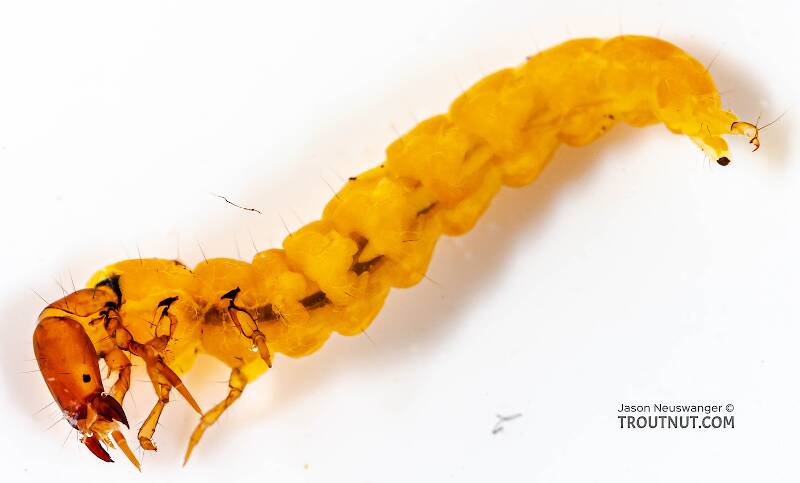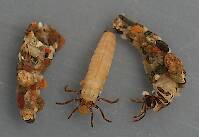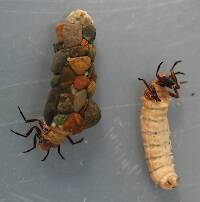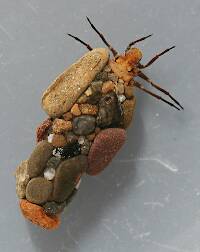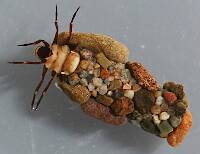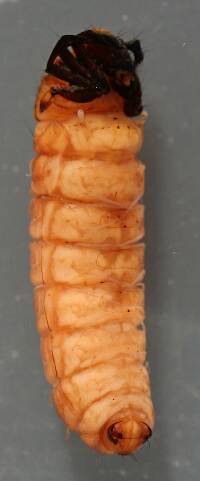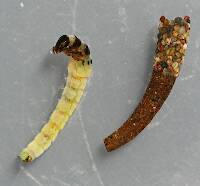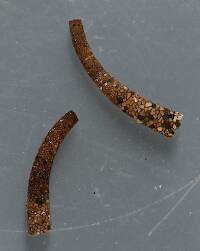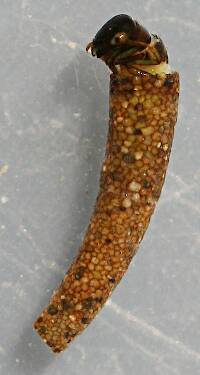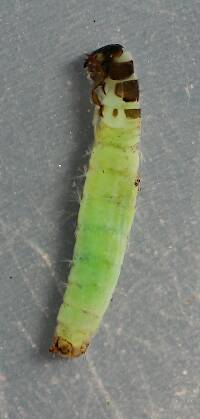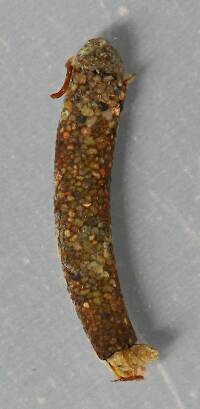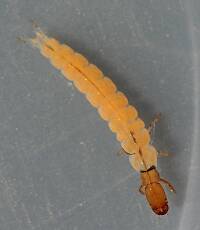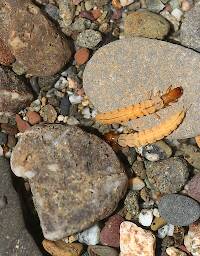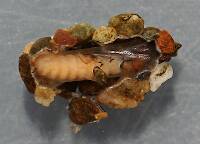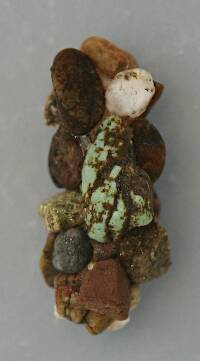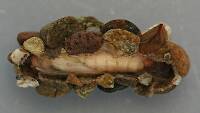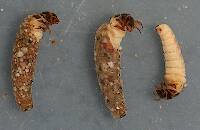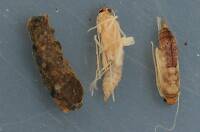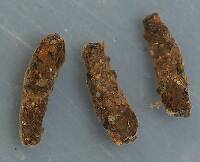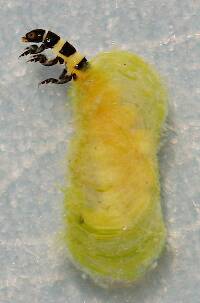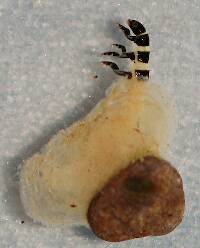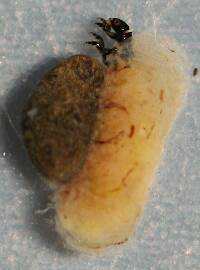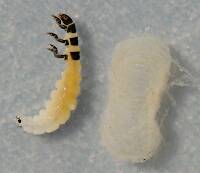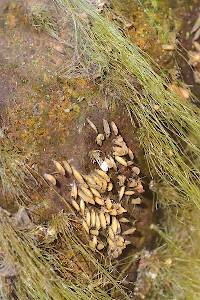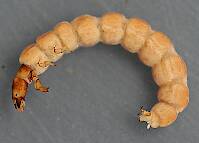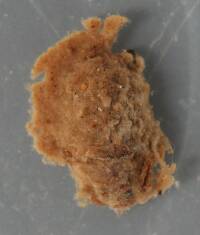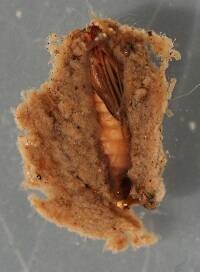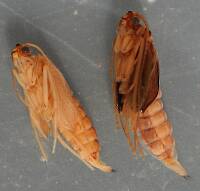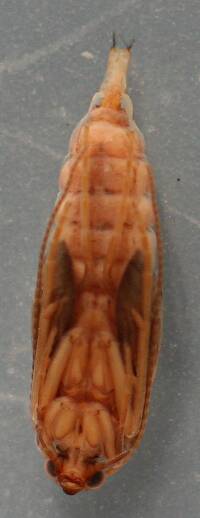
Salmonflies
Pteronarcys californica
The giant Salmonflies of the Western mountains are legendary for their proclivity to elicit consistent dry-fly action and ferocious strikes.
Featured on the forum

It's only barely visible in one of my pictures, but I confirmed under the microscope that this one has a prosternal horn and the antennae are mid-way between the eyes and front of the head capsule.
I'm calling this one Pycnopsyche, but it's a bit perplexing. It seems to key definitively to at least Couplet 8 of the Key to Genera of Limnephilidae Larvae. That narrows it down to three genera, and the case seems wrong for the other two. The case looks right for Pycnopsyche, and it fits one of the key characteristics: "Abdominal sternum II without chloride epithelium and abdominal segment IX with only single seta on each side of dorsal sclerite." However, the characteristic "metanotal sa1 sclerites not fused, although often contiguous" does not seem to fit well. Those sclerites sure look fused to me, although I can make out a thin groove in the touching halves in the anterior half under the microscope. Perhaps this is a regional variation.
The only species of Pycnopsyche documented in Washington state is Pycnopsyche guttifera, and the colors and markings around the head of this specimen seem to match very well a specimen of that species from Massachusetts on Bugguide. So I am placing it in that species for now.
Whatever species this is, I photographed another specimen of seemingly the same species from the same spot a couple months later.
I'm calling this one Pycnopsyche, but it's a bit perplexing. It seems to key definitively to at least Couplet 8 of the Key to Genera of Limnephilidae Larvae. That narrows it down to three genera, and the case seems wrong for the other two. The case looks right for Pycnopsyche, and it fits one of the key characteristics: "Abdominal sternum II without chloride epithelium and abdominal segment IX with only single seta on each side of dorsal sclerite." However, the characteristic "metanotal sa1 sclerites not fused, although often contiguous" does not seem to fit well. Those sclerites sure look fused to me, although I can make out a thin groove in the touching halves in the anterior half under the microscope. Perhaps this is a regional variation.
The only species of Pycnopsyche documented in Washington state is Pycnopsyche guttifera, and the colors and markings around the head of this specimen seem to match very well a specimen of that species from Massachusetts on Bugguide. So I am placing it in that species for now.
Whatever species this is, I photographed another specimen of seemingly the same species from the same spot a couple months later.

Troutnut is a project started in 2003 by salmonid ecologist Jason "Troutnut" Neuswanger to help anglers and
fly tyers unabashedly embrace the entomological side of the sport. Learn more about Troutnut or
support the project for an enhanced experience here.
GONZO on Apr 3, 2007April 3rd, 2007, 5:27 am EDT
If I'm seeing things correctly, this appears to be Chimarra.
Martinlf on Apr 4, 2007April 4th, 2007, 1:14 am EDT
Are imitations of this larva effective? Charlie Meck claims they are, and I wonder if the fish actually see them and eat them, or are primarily responding to his little orange worm as an attractor. Any ideas?
"He spread them a yard and a half. 'And every one that got away is this big.'"
--Fred Chappell
--Fred Chappell
Troutnut on Apr 4, 2007April 4th, 2007, 4:21 am EDT
I've never tried. When I've found them, it's usually just two or three larvae in a sample with hundreds of Ephemerella and Baetid mayflies and Hydropsychid caddisflies and other more common critters. It's safe to say they're not a major food source on the streams I've sampled, but perhaps they're locally abundant elsewhere.
Jason Neuswanger, Ph.D.
Troutnut and salmonid ecologist
Troutnut and salmonid ecologist
GONZO on Apr 4, 2007April 4th, 2007, 5:51 am EDT
Louis,
On streams where they are abundant (the Brodheads and the Yellow Breeches are two examples of very different streams with good populations) the imitations are good for both of the reasons you mention. Like the bright green Rhyacophila larvae, they combine imitation and attraction. The best populations are usually in larger waters.
On streams where they are abundant (the Brodheads and the Yellow Breeches are two examples of very different streams with good populations) the imitations are good for both of the reasons you mention. Like the bright green Rhyacophila larvae, they combine imitation and attraction. The best populations are usually in larger waters.
Martinlf on Apr 4, 2007April 4th, 2007, 6:42 am EDT
Pattern suggestions? Dubbing color?
"He spread them a yard and a half. 'And every one that got away is this big.'"
--Fred Chappell
--Fred Chappell
GONZO on Apr 4, 2007April 4th, 2007, 7:33 am EDT
Pretty simple--a little curved hook, dark yellow to yellowish orange dubbing (rib with fine gold wire, if you like), thread legs or yellow/orange-dyed partridge fibers (optional), brown head.
While the larval pattern can be a useful searching fly, my favorite aspect of Chimarra is fishing the emerging pupae. You need to locate an emergence site where the pupae crawl out in large numbers. Sometimes you can do this by looking for concentrations of the recently hatched adults on the underside of leaves and wood low along the edge of the stream. The coolest thing, however, is that if you stand for any length of time in a good site during the emergence time, the freshly hatched adults will soon be all over your waders above the waterline. Then you simply need to tie on a little black pupa and crawl it along the bottom!
While the larval pattern can be a useful searching fly, my favorite aspect of Chimarra is fishing the emerging pupae. You need to locate an emergence site where the pupae crawl out in large numbers. Sometimes you can do this by looking for concentrations of the recently hatched adults on the underside of leaves and wood low along the edge of the stream. The coolest thing, however, is that if you stand for any length of time in a good site during the emergence time, the freshly hatched adults will soon be all over your waders above the waterline. Then you simply need to tie on a little black pupa and crawl it along the bottom!
Mlajoie
Posts: 6
Posts: 6
Mlajoie on Mar 19, 2008March 19th, 2008, 6:46 am EDT
In response to the original comment: Not that the correct genus of Philopotamid matters when tying/using flies, but you would be able to get an easy ID if you could see a top-view of the head capsule. Chimarra sp. has an obvious emargination at the apex of the frontoclypeus. Dolophilodes and Wormaldia can be identified by the shapes of their frontoclypeal sutures. In the future, take closeups looking down on the head for ID purposes.
Troutnut on Mar 19, 2008March 19th, 2008, 7:41 am EDT
Thanks, I'll give that a try.
Jason Neuswanger, Ph.D.
Troutnut and salmonid ecologist
Troutnut and salmonid ecologist
Kroil on Mar 19, 2008March 19th, 2008, 11:52 am EDT
I would say they are a crucial early season protein source in the catskills. I would even bet that they make up a large percentage of the early season invertabrate flow as a trout food. My autopsies have shown this (both pupal and adult stage) and I seem to dupe quite a few early season fish in slow hatch periods with smallish 18/20 black/charcoal patterns.
I can't speak to the effectiveness of pupal or emerging patterns,'cuz Dave don't do that kinda fishing.
I can't speak to the effectiveness of pupal or emerging patterns,'cuz Dave don't do that kinda fishing.
When I found the skull in the woods, the first thing I did was call the police. But then I got curious about it. I picked it up, and started wondering who this person was, and why he had deer horns. - Jack Handey
Martinlf on Mar 24, 2008March 24th, 2008, 12:46 pm EDT
When there are no rises when Chimarra are active one can find fish taking small peacock and starling wet flies either dead drifted or on the swing.
"He spread them a yard and a half. 'And every one that got away is this big.'"
--Fred Chappell
--Fred Chappell
Jonsecrist on Jan 22, 2011January 22nd, 2011, 5:48 am EST
I have them on my little home stream in va. Red bud run. I found a 16,18 curved hook,or a reversed bend hook. Ornge or sulphur dubing,7x mono for rib,brown or ginger hackle with a little brown biot pulled over for wing case.works great.
Scott g2
Crepuscular on Feb 20, 2014February 20th, 2014, 11:05 am EST
Does anybody know if this caddis larva has a pupa that is orange-yellow about a size 16.
The pupae are dark, almost black.
TNEAL on Feb 20, 2014February 20th, 2014, 11:13 am EST
ditto to Louis' remark about peacock bodied soft hackle flies.... less than two minutes to tie and very effective...
Martinlf on Feb 20, 2014February 20th, 2014, 5:47 pm EST
October caddis, for one, but they are big fellows.
"He spread them a yard and a half. 'And every one that got away is this big.'"
--Fred Chappell
--Fred Chappell
Entoman on Feb 20, 2014February 20th, 2014, 8:31 pm EST
How are you collecting them?
"It's not that I find fishing so important, it's just that I find all other endeavors of Man equally unimportant... And not nearly as much fun!" Robert Traver, Anatomy of a Fisherman
Oldredbarn on Feb 21, 2014February 21st, 2014, 6:45 am EST
the one I am thinking of that I have caught was about a size 16-ish. I have caught them in June.
Mack...I'm surprised! "was about a size 16-ish'...Now that's "swinging" with science. :) You know its not a goal until it crosses the line, not almost crosses the line...'ish"...Hmmmm.
Yesterday's Gold Medal game in women's hockey was an incredible game. The US girls out played the Canadians all but the last three crucial minutes. One of the better played games I've seen in a long time. The US fore-checked wonderfully and worked the boards like they were playing for the Stanley Cup. Heartbreaking. The Canadians first goal was a mis-cued shot that went off in an odd direction and hit one of our forwards and went in.
Today its the mens turn...
"Even when my best efforts fail it's a satisfying challenge, and that, after all, is the essence of fly fishing." -Chauncy Lively
"Envy not the man who lives beside the river, but the man the river flows through." Joseph T Heywood
"Envy not the man who lives beside the river, but the man the river flows through." Joseph T Heywood
Jmd123 on Feb 21, 2014February 21st, 2014, 8:30 am EST
Leave it up to Spence to bring this thread around to hockey...;oD
Jonathon
Jonathon
No matter how big the one you just caught is, there's always a bigger one out there somewhere...
Entoman on Feb 21, 2014February 21st, 2014, 2:27 pm EST
Hey, RU gonna answer my question or gloat about Hockey! :)
"It's not that I find fishing so important, it's just that I find all other endeavors of Man equally unimportant... And not nearly as much fun!" Robert Traver, Anatomy of a Fisherman
Entoman on Feb 21, 2014February 21st, 2014, 5:13 pm EST
That was a quick edit!
In the drift near the surface or knocked from rocks?
Yes, I did. Interesting man. I hope you are able to help his family.
In the drift near the surface or knocked from rocks?
Yes, I did. Interesting man. I hope you are able to help his family.
"It's not that I find fishing so important, it's just that I find all other endeavors of Man equally unimportant... And not nearly as much fun!" Robert Traver, Anatomy of a Fisherman
Taxon on Feb 21, 2014February 21st, 2014, 9:02 pm EST
Please forgive my confusion, but isn't this thread titled Specimen Discussion > Chimarra :-)
Quick Reply
Related Discussions
Topic
Replies
Last Reply
4
Oct 29, 2014
by Millcreek
by Millcreek
8
Aug 25, 2014
by Millcreek
by Millcreek


